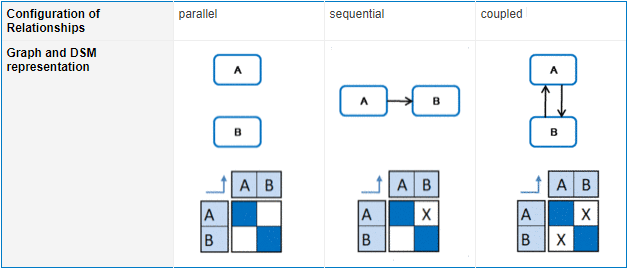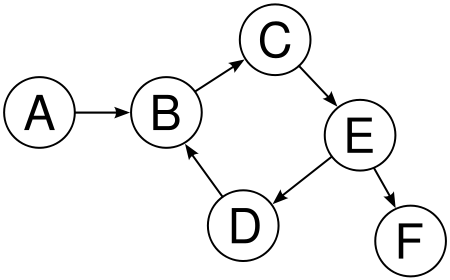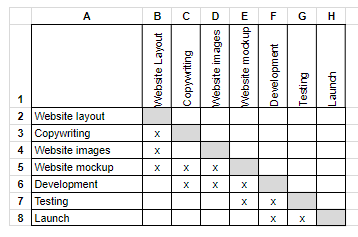KEY TAKEAWAYS
Project delays mean wasted time, money, and opportunity, and one of the major reasons they happen is mismanagement of dependencies. In this article, we’ll talk about a tool used to visualize project dependencies and ultimately optimize project schedules and sequences: the project dependency matrix.
What is a Project Dependency Matrix?
Also called project dependency structure matrix and other project management terms like design precedence matrix, dependency source matrix, or simply dependency matrix, a project dependency matrix is a square matrix-based method used as a visual representation of dependencies for each part or task within a project. It is particularly useful for tasks that tend to be repeated across several projects because it allows teams to plan the sequence of when they accomplish things ahead.
There are two types of project dependency matrices: static and time-based.
A static design structure matrix (DSM) represents elements that exist simultaneously. This can be used to represent components of a machine and which other elements they’re related to. In this case, the parts of the machine all exist at the same time, but plotting dependencies would be useful so that whenever one part malfunctions, the other related parts can be checked for its repair. This can also be useful for software features for smoother testing and bug-fixing.
In project management, the time-based DSM is usually more relevant as it models tasks and requirements that come into fruition at different parts of the project timeline. This can be used for construction projects, marketing projects, product development projects, and several other fields.
4 Types of Dependencies in Project Management
Dependencies are the relationships between a project’s tasks or components. They can be internal or external, mandatory or discretionary, sequential or parallel. These relationships determine the optimal order, duration, and resources that the project plan should be based on.
There are four dependency relationship types that project components may share: finish to start, start to finish, start to start, and finish to finish.
Finish to Start (FtS)
The finish to start dependency is an example of a sequential dependency, meaning task A must be completed before task B can begin. This can be due to several reasons, such as shared resources.
For example, there is only one creative in your marketing team. For them to work on your promotional video, they need to finish working on your other requirements first because they are a singular resource that needs to be present to start creative tasks.
Start to Finish (StF)
The start to finish dependency is applicable to tasks that overlap and for situations where there are successors. Motion gives a good visual to imagine this, which is during relay races where the last runner can’t start without the previous runner passing the baton. The previous runner’s action begins the completion of the final runner’s task.
An example of an StF dependency is project turnovers. When a team member is transferred to a different team, an effective project turnover usually involves an overlap. The leaving member can only complete their transfer after the successor is equipped to resume the tasks they will leave behind.
Start to Start (StS)
The start to start dependency means that one task B can only start once task A has started. An example of this is product design and development and product promotion.
Before product promotion can start, it’s ideal that a solid design has already been decided and early developments have started, even if it’s just for prototypes. This way, the promotion team will have a good grasp of what they’re promoting and the customer transformations the product will offer.
Finish to Finish (FtF)
In the finish to finish dependency, a task can only finish once the other is finished as well. An example is in software development where the programmers need to create the code and the quality assurance testers need to test them to ensure that they work as intended. In this scenario, the programming task can only be finished when the testers finish their task and eventually clear the build for submission.
How to Create a Project Dependency Matrix from Scratch
Step 1: Define project scope
So before you can begin to analyze the tasks and components of your project, you’ll need to be clear about the scope of your list in relation to your project objective. Putting too much or too little detail in your project dependency matrix will be counter-productive to this exercise, so it’s important to be clear, early on, about what you want to cover and what you plan to exclude.
Step 2: Identify project elements
Once you’ve identified your scope, it’s time to break your project down into tangible tasks and components. Involve your teammates during this step. This will give you a holistic perspective on what needs to be covered and can shed light on the small but crucial elements that you may miss as a project manager but are crucial to your team’s daily progress.
Step 3: Fill out the square graph
The main rule in filling out a dependency matrix square graph is that the rows should be identical to the columns. This means that both the element name and the order of the elements should be the same. List them down in an order that makes sense to you.

You can mark the diagonal element of the matrix too. This means shading the cells where two identical tasks meet. The diagonal elements of the matrix do not have any interpretation in describing the system, so they are usually either left empty or grayed out.
Step 4: Mark dependencies
You can either choose to make a binary matrix or a numerical matrix. The binary matrix means that the cells are either marked with a one or a zero. If a relationship exists between the items, an “X” is placed on the cell. If there’s none, it’s left blank.
In a numerical matrix, instead of just ones and zeroes, a number that represents weighted dependency is used.
Step 5: Rearrange and optimize
Now that the presence—or absence—of relationships among your project components is visible to you, it’s time to identify the best sequence of tasks to ensure that progress is smooth as you go along. You’ll find that tasks that relate to each other may have a parallel, sequential, or coupled relationship.

Parallel tasks are unrelated to each other. They share no dependency and can be done separately. Sequential tasks need to be done one after the other. Coupled tasks need to be done together. Information exchange may be important here.
To optimize the process, project managers use clustering to facilitate modularity, or sequencing to minimize cost and schedule risk in process. Sequencing involves reordering rows and columns so that the new DSM arrangement dependencies are accomplished on time. Clustering is the grouping of project components that are interconnected amongst themselves, while being little connected to the rest of the system.
Additional step: Create directed graphs
Directed graphs are visual flowcharts composed of nodes that represent project elements, and arrows to represent directional influence or which element is dependent on what. In many cases, this is drawn after project elements are identified (step 2).

It is also possible to do this after the dependency matrix has been created. This way, it can be used as a visual representation of the optimal sequence of project tasks that would be easier for the team and external stakeholders to digest.
How to Read a Project Dependency Matrix
As discussed, the rows and columns of a project dependency matrix contains the project tasks. The marks within the graph represent relationships between the tasks.

In the simple website development project dependency matrix above, you’ll find that the tasks listed in column A and in row 1 are the tasks involved in the project. Within the table, you’ll see Xs that represent which tasks are related.
Rows indicate which components are needed to complete the task. For example, for website development (row 6) to be done, the copywriting (column C), website images (column D), and website mockup (column E) need to have been completed already.
Columns show which project components are affected by the task. In the example above, we can conclude that if development (column F) is delayed, testing (row 7) and the launch (row 8) will also be delayed.
Counting the number of Xs will help you determine which tasks pose the most and the least risk when mismanaged and which could be handy when receiving change requests and during decision-making.
Things to Consider When Creating a Dependency Matrix
Level of detail
Your dependency matrix can be as simple or as detailed as you want. As discussed, the binary dependency matrix simply marks the presence or absence of relationships between tasks and components. If you need more detail, a weighted dependency matrix is an option. This will indicate the size of an impact each task has with another, which helps in planning and decision-making.
The level of detail you need for your dependency matrix will be based on several factors, including what you intend to use it for, what will be most useful for different types of stakeholders, and so on. Discern these properly to ensure that details are neither insufficient nor overwhelming.
Tools and maintenance
To maximize your project dependency matrix, it’s advisable to ensure it’s updated and maintained. This can be challenging especially for complex projects. To do this effectively, it’s important to pick the best tools for the job. Choose a tool that has reliable functionality and one that you can effectively use. This way, you can easily keep your project dependency matrix up-to-date and useful.
Knowledge and training
The project dependency matrix will only be as useful as your stakeholders’ capability to understand it, so it’s important to ensure that your team and relevant stakeholders know how to interpret the matrix. This helps strengthen alignment and collaboration, which can positively impact the results of your project.
How to Use a Dependency Matrix Efficiently
Involve your team
Collaborating with your team as you create and put into use your project dependency matrix allows you to thoroughly understand your project elements and lessen the possibility of things falling through the cracks.
As a project manager, there are limits to which components you have direct control of, so it pays to have the insight and contribution of your team members who deal with project components firsthand.
Additionally, this dependency matrix is created so the team can smoothly proceed with their tasks with as little disruptions and blockers as possible. Involving them in the process will not only add accuracy and detail, it will also increase their investment and belief in the insight it provides and the project plans that will be created because of it.
Monitor often and update accordingly
As circumstances change, even established projects and processes may encounter changes. For example, with the rise of artificial intelligence, some dependencies that relied on external parties could become manageable for your internal team. This might decrease the weight of impact on the dependency of the information to the success of your project. Additional resources might also be introduced, so dependencies reliant on manpower might start to decrease.
For your project dependency matrix to be reliable, it’s important to monitor and update it regularly. And it is equally important to use tools that will allow for these changes to be applied without ruining the whole thing.
Put insights into action
Insights are great, but they can only positively affect your project when you apply them to your plans and processes as you move forward. Ensure that insights from the diagram are turned into actionable process improvements documented through team SOPs to maximize the information you uncover as you optimize your project dependency matrix.
Benefits of Using a Dependency Matrix in Project Management
Improved visibility and representation
Like the requirements traceability matrix that helps teams see the relationship between project requirements and project work, a project dependency matrix shows a clear map of the complex relationships of project components. If done right and is easily digestible for everyone, the project dependency matrix gives the team visibility and proper representation that allow for smoother teamwork, collaboration, negotiation, and decision-making. When all parties understand the elements of the project, they can weigh in solutions for ongoing problems with the proper context. This enables project managers to maximize the expertise of each team member more effectively.
Risk and change management
The project dependency matrix effectively represents all areas of the project that will be affected when certain changes are made to project elements. With its help, all stakeholders can easily understand the impact and risks that proposed changes will affect, allowing all involved parties to manage and mitigate them.
Avoiding blockers
With dependencies out in the open, project managers can prepare resources in advance so the team always has everything they need to maintain progress. In the same way, having external parties understand the impact of the dependencies they’re in charge of will motivate them to submit deliverables in a more timely manner.
Challenges and Limitations of Project Dependency Matrix
Accuracy is vital
The project dependency matrix will only truly be effective if the information is accurate and all relationships among the project elements are accounted for. This can be challenging to do from the get-go, so being open to continuously updating the project dependency matrix is essential.
Challenging for new projects
For new projects that the project team has no experience dealing with, creating an accurate project dependency matrix can be a massive challenge. If it’s the team’s first project dependency matrix for a new project, it’s important to manage expectations and acknowledge that it’s a work-in-progress. This also needs to be taken into account when using the project dependency matrix in making crucial project decisions.
Limited amount of detail
The purpose of the project dependency matrix is to map out the relationships among project elements. It doesn’t display the durations of tasks, resources needed to accomplish each task, and even the timeline for when they will be tackled.
The project dependency matrix is an effective tool you can use to determine the optimal sequences for your project elements, but remember that it can’t be used independently from other project management tools. To create a comprehensive project plan, it is vital to use the project dependency matrix along with tools like Gantt charts, work breakdown structures, and more.
Wrapping Up
Projects have dependencies that need to be thoroughly understood when creating project plans. The sequence at which elements are tackled can majorly affect the cadence of the project’s progress. Project dependency matrices can help map out dependencies so project teams can determine the best sequence of tasks to do to maximize the efficiency of their project process.
‘






